Pushover Tests on Unreinforced Masonry Wallettes Retrofitted with an Innovative Coating: Experimental Study and Finite Element Modelling
Abstract
:1. Introduction
2. Material Properties and Wall Experiments
2.1. Material Properties
2.1.1. Bricks
2.1.2. Thin-Mortar Joints
2.1.3. ISO and MGF Coatings
2.2. Wall Specimens
2.3. Experimental Protocol
2.4. Experimental Results
- The shear stresses along the horizontal joint could be neglected in a first approach;
- The cracks generated in the coating thickness would be negligible compared to the coating thickness;
- Along the vertical joints and the brick cracks at failure, the coating would be subject to a constant tensile stress equal to its tensile strength over its full height, and the tensile behaviour of the coating would be elastoplastically rigid [23].
3. Numerical Modelling
3.1. Presentation of the Numerical Approach
3.2. Calibration and Simulation Results
3.3. Limitations of the Model
3.4. Influence of the Vertical Loading Mode
4. Conclusions and Perspectives
Author Contributions
Funding
Institutional Review Board Statement
Informed Consent Statement
Data Availability Statement
Acknowledgments
Conflicts of Interest
References
- Ibrahim, M.; Biwole, P.H.; Wurtz, E.; Achard, P. Limiting windows offset thermal bridge losses using a new insulating coating. Appl. Energy 2014, 123, 220–231. [Google Scholar] [CrossRef]
- Ibrahim, M.; Biwole, P.H.; Wurtz, E.; Achard, P. A study on the thermal performance of exterior walls covered with a recently patented silica-aerogel-based insulating coating. Build. Environ. 2014, 81, 112–122. [Google Scholar] [CrossRef]
- AFNOR; NFEN. Eurocode 8: Design of Structures for Earthquake Resistance—Part 1: General Rules, Seismic Actions and Rules for Buildings (EN 1998-1: 2004); European Committee for Standardization: Brussels, Belgium, 2004. [Google Scholar]
- Bui, M.; Eymard, O.; Plé, J.P.; Plassiard, P.P. Influence d’un Enduit D’ isolation Thermique Sur le Comportement Parasismique des Murs en Maçonnerie Non- Renforcée. In Proceedings of the 9ème Colloque AFPS, Marne la Vallée, France, 30 November–2 December 2015. [Google Scholar]
- Bournas, D.A. Concurrent seismic and energy retrofitting of RC and masonry building envelopes using inorganic textile-based composites combined with insulation materials: A new concept. Compos. Part B Eng. 2018, 148, 166–179. [Google Scholar] [CrossRef]
- Mistretta, F.; Stochino, F.; Sassu, M. Structural and thermal retrofitting of masonry walls: An integrated cost-analysis approach for the Italian context. Build. Environ. 2019, 155, 127–136. [Google Scholar] [CrossRef]
- Casacci, S.; Gentilini, C.; Di Tommaso, A.; Oliveira, D.V. Shear strengthening of masonry wallettes resorting to structural repointing and FRCM composites. Constr. Build. Mater. 2019, 206, 19–34. [Google Scholar] [CrossRef]
- Ismail, N.; Ingham, J.M. In-plane and out-of-plane testing of unreinforced masonry walls strengthened using polymer textile reinforced mortar. Eng. Struct. 2016, 118, 167–177. [Google Scholar] [CrossRef]
- Mahmood, H.; Ingham, J. Diagonal compression testing of FRP-Retrofitted Unreinforced Clay Brick Masonry Wallettes. J. Compos. Constr. 2011, 15, 810–820. [Google Scholar] [CrossRef] [Green Version]
- Parisi, F.; Iovinella, I.; Balsamo, A.; Augenti, N.; Prota, A. Composites: Part B In-plane behaviour of tuff masonry strengthened with inorganic matrix—Grid composites. Compos. Part B 2013, 45, 1657–1666. [Google Scholar] [CrossRef]
- Corradi, M.; Borri, A.; Castori, G.; Sisti, R. Composites: Part B Shear strengthening of wall panels through jacketing with cement mortar reinforced by GFRP grids. Compos. Part B 2014, 64, 33–42. [Google Scholar] [CrossRef] [Green Version]
- Gattesco, N.; Amadio, C.; Bedon, C. Experimental and numerical study on the shear behavior of stone masonry walls strengthened with GFRP reinforced mortar coating and steel-cord reinforced repointing. Eng. Struct. 2015, 90, 143–157. [Google Scholar] [CrossRef] [Green Version]
- Longo, F.; Cascardi, A.; Lassandro, P.; Aiello, M.A. Energy and seismic drawbacks of masonry: A unified retrofitting solution. J. Build. Pathol. Rehabil. 2021, 6, 31. [Google Scholar] [CrossRef]
- Triantafillou, T.C.; Karlos, K.; Kefalou, K.; Argyropoulou, E. An innovative structural and energy retrofitting system for URM walls using textile reinforced mortars combined with thermal insulation: Mechanical and fire behavior. Constr. Build. Mater. 2017, 133, 1–13. [Google Scholar] [CrossRef]
- Sellier, A.; Casaux-Ginestet, G.; Buffo-Lacarrière, L.; Bourbon, X. Orthotropic damage coupled with localized crack reclosure processing Part II: Applications. Eng. Fract. Mech. 2013, 97, 168–185. [Google Scholar] [CrossRef]
- Vacher, P.; Dumoulin, S.; Morestin, F.; Mguil-Touchal, S. Bidimensional strain measurement using digital images. Proc. Inst. Mech. Eng. Part C J. Mech. Eng. Sci. 1999, 213, 811–817. [Google Scholar] [CrossRef]
- Eymard, M. Analyse du Comportement Mécanique de L’interface Entre un Enduit D’isolation Thermique Innovant et Son Support Structurel. Ph.D. Thesis, Université de Grenoble, Saint-Martin-d’Hères, France, 2014. [Google Scholar]
- Santa-Maria, H.; Alcaino, P. Repair of in-plane shear damaged masonry walls with external FRP. Constr. Build. Mater. 2011, 25, 1172–1180. [Google Scholar] [CrossRef]
- Bui, T.L.; Si Larbi, A.; Reboul, N.; Ferrier, E. Shear behaviour of masonry walls strengthened by external bonded FRP and TRC. Compos. Struct. 2015, 132, 923–932. [Google Scholar] [CrossRef]
- Borri, A.; Corradi, M.; Castori, G.; Molinari, A. Stainless steel strip—A proposed shear reinforcement for masonry wall panels. Constr. Build. Mater. 2019, 211, 594–604. [Google Scholar] [CrossRef]
- Menna, C.; Asprone, D.; Durante, M.; Zinno, A.; Balsamo, A.; Prota, A. Structural behaviour of masonry panels strengthened with an innovative hemp fibre composite grid. Constr. Build. Mater. 2015, 100, 111–121. [Google Scholar] [CrossRef]
- Tomaževič, M.; Weiss, P. Robustness as a criterion for use of hollow clay masonry units in seismic zones: An attempt to propose the measure. Mater. Struct. Constr. 2012, 45, 541–559. [Google Scholar] [CrossRef]
- Eymard, M.; Plassiard, J.P.; Perrotin, P.; Le Fay, S. Interfacial strength study between a concrete substrate and an innovative sprayed coating. Constr. Build. Mater. 2015, 19, 345–356. [Google Scholar] [CrossRef]
- Lourenço, P.B. Computational Strategies for Masonry Structures; TU Delft: Delft, The Netherlands, 1996. [Google Scholar]
- Bertolesi, E.; Milani, G.; Fagone, M.; Rotunno, T.; Grande, E. Micro-mechanical FE numerical model for masonry curved pillars reinforced with FRP strips subjected to single lap shear tests. Compos. Struct. 2018, 201, 916–931. [Google Scholar] [CrossRef]
- Ombres, L.; Verre, S. Experimental and Numerical Investigation on the Steel Reinforced Grout (SRG) Composite-to-Concrete Bond. J. Compos. Sci. 2020, 4, 182. [Google Scholar] [CrossRef]
- Scacco, J.; Ghiassi, B.; Milani, G.; Lourenço, P.B. A fast modeling approach for numerical analysis of unreinforced and FRCM reinforced masonry walls under out-of-plane loading. Compos. Part B Eng. 2020, 180, 107553. [Google Scholar] [CrossRef]
- Sellier, A.; Casaux-Ginestet, G.; Buffo-Lacarrière, L.; Bourbon, X. Orthotropic damage coupled with localized crack reclosure processing. Part I: Constitutive laws. Eng. Fract. Mech. 2013, 97, 149–167. [Google Scholar] [CrossRef]
- Hillerborg, A.; Modéer, M.; Petersson, P.E. Analysis of crack formation and crack growth in concrete by means of fracture mechanics and finite elements. Cem. Concr. Res. 1976, 6, 773–781. [Google Scholar] [CrossRef]
- Plassiard, J.-P.; Alachek, I.; Plé, O. Damage-based finite-element modelling of in-plane loaded masonry walls repaired with FRCM. Comput. Struct. 2021, 254, 106481. [Google Scholar] [CrossRef]
- D’Altri, A.M.; Carloni, C.; de Miranda, S.; Castellazzi, G. Numerical modeling of FRP strips bonded to a masonry substrate. Compos. Struct. 2018, 200, 420–433. [Google Scholar] [CrossRef]
- Zhang, S.; Yang, D.; Sheng, Y.; Garrity, S.W.; Xu, L. Numerical modelling of FRP-reinforced masonry walls under in-plane seismic loading. Constr. Build. Mater. 2017, 134, 649–663. [Google Scholar] [CrossRef]
- Murgo, F.S.; Mazzotti, C. Masonry columns strengthened with FRCM system: Numerical and experimental evaluation. Constr. Build. Mater. 2019, 202, 208–222. [Google Scholar] [CrossRef]
- Basili, M.; Vestroni, F.; Marcari, G. Brick masonry panels strengthened with textile reinforced mortar: Experimentation and numerical analysis. Constr. Build. Mater. 2019, 227, 117061. [Google Scholar] [CrossRef]
- Fayala, I.; Limam, O.; Stefanou, I. Experimental and numerical analysis of reinforced stone block masonry beams using GFRP reinforcement. Compos. Struct. 2016, 152, 994–1006. [Google Scholar] [CrossRef] [Green Version]
- Scacco, J.; Milani, G.; Lourenço, P.B. A micro-modeling approach for the prediction of TRM bond performance on curved masonry substrates. Compos. Struct. 2021, 256, 113065. [Google Scholar] [CrossRef]
- Caggegi, C.; Carozzi, F.G.; De Santis, S.; Fabbrocino, F.; Focacci, F.; Hojdys, Ł.; Lanoye, E.; Zuccarino, L. Experimental analysis on tensile and bond properties of PBO and aramid fabric reinforced cementitious matrix for strengthening masonry structures. Compos. Part B Eng. 2017, 127, 175–195. [Google Scholar] [CrossRef]
- Lignola, G.P.; Caggegi, C.; Ceroni, F.; De Santis, S.; Krajewski, P.; Lourenço, P.B.; Morganti, M.; Papanicolaou, C.; Pellegrino, C.; Prota, A.; et al. Performance assessment of basalt FRCM for retrofit applications on masonry. Compos. Part B Eng. 2017, 128, 1–18. [Google Scholar] [CrossRef]
- Bertolesi, E.; Milani, G.; Ghiassi, B. Numerical Modeling of Masonry and Historical Structures—From Theory to Application; Woodhead Publishing: Sawston, UK, 2019; ISBN 9780081024393. [Google Scholar]
- Calvi, G.M.; Kingsley, G.R.; Magenes, G. Testing of masonry structures for seismic assessment. Earthq. Spectra 1996, 12, 145–162. [Google Scholar] [CrossRef]
- Aşıkoğlu, A.; Vasconcelos, G.; Lourenço, P.B.; Pantò, B. Pushover analysis of unreinforced irregular masonry buildings: Lessons from different modeling approaches. Eng. Struct. 2020, 218, 110830. [Google Scholar] [CrossRef]
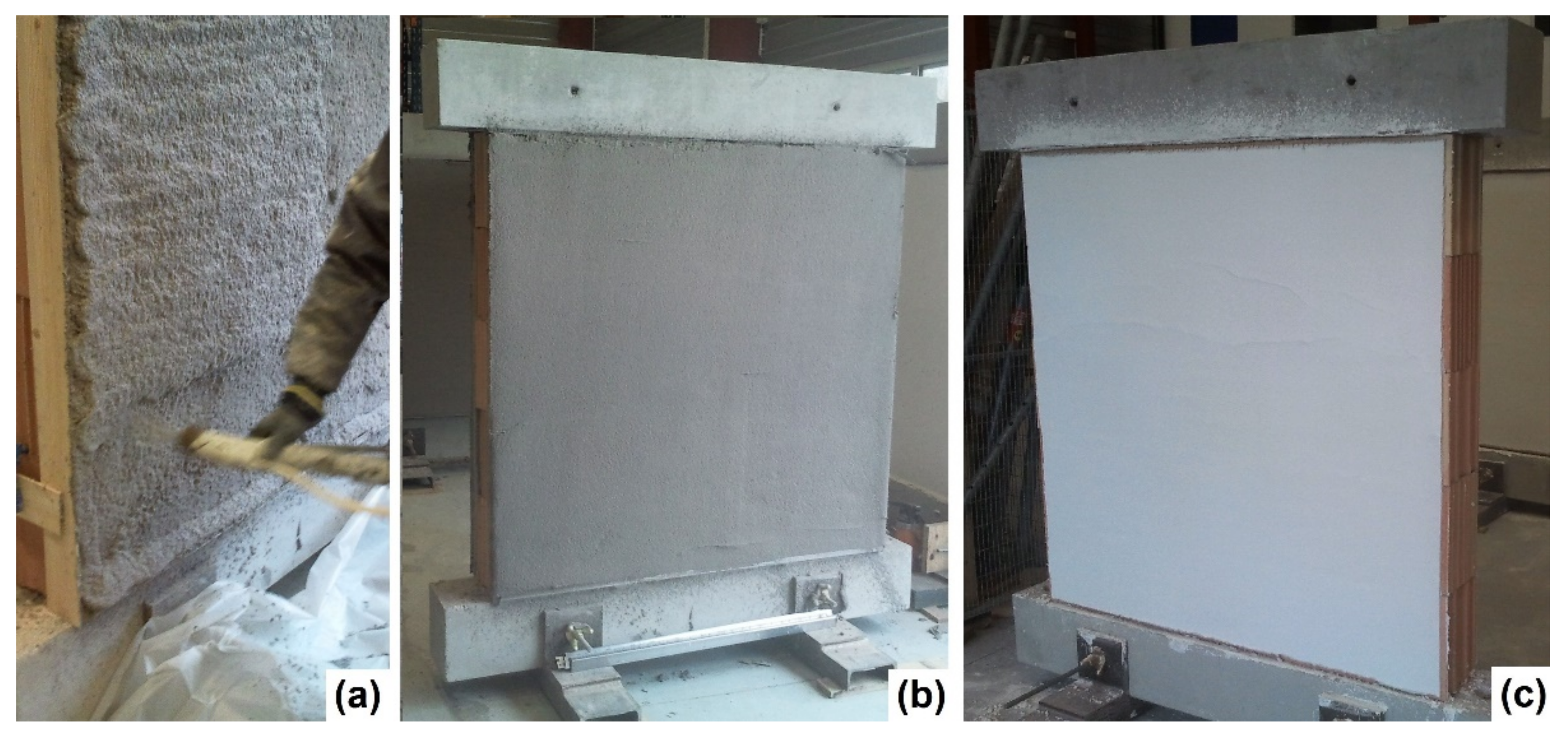
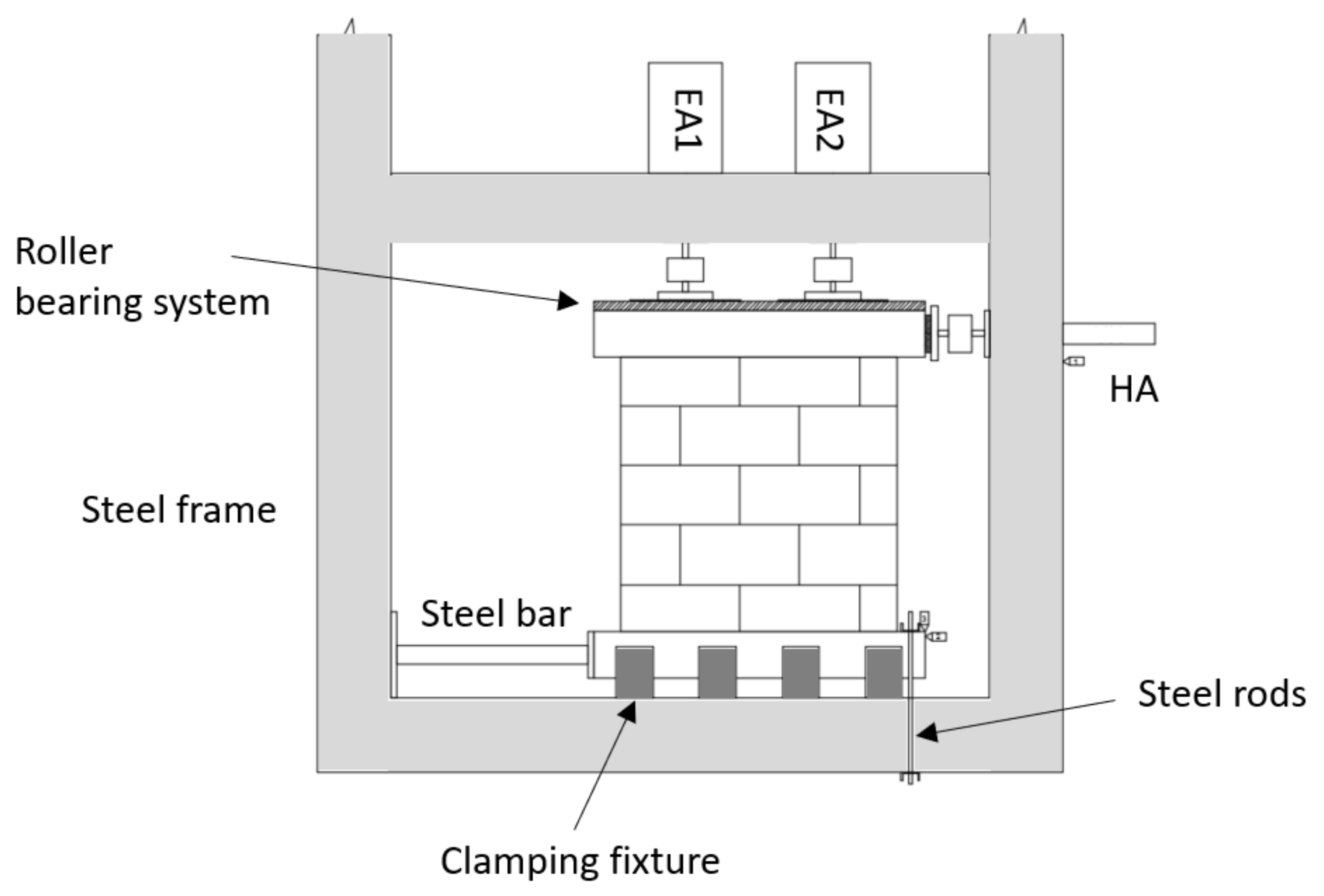

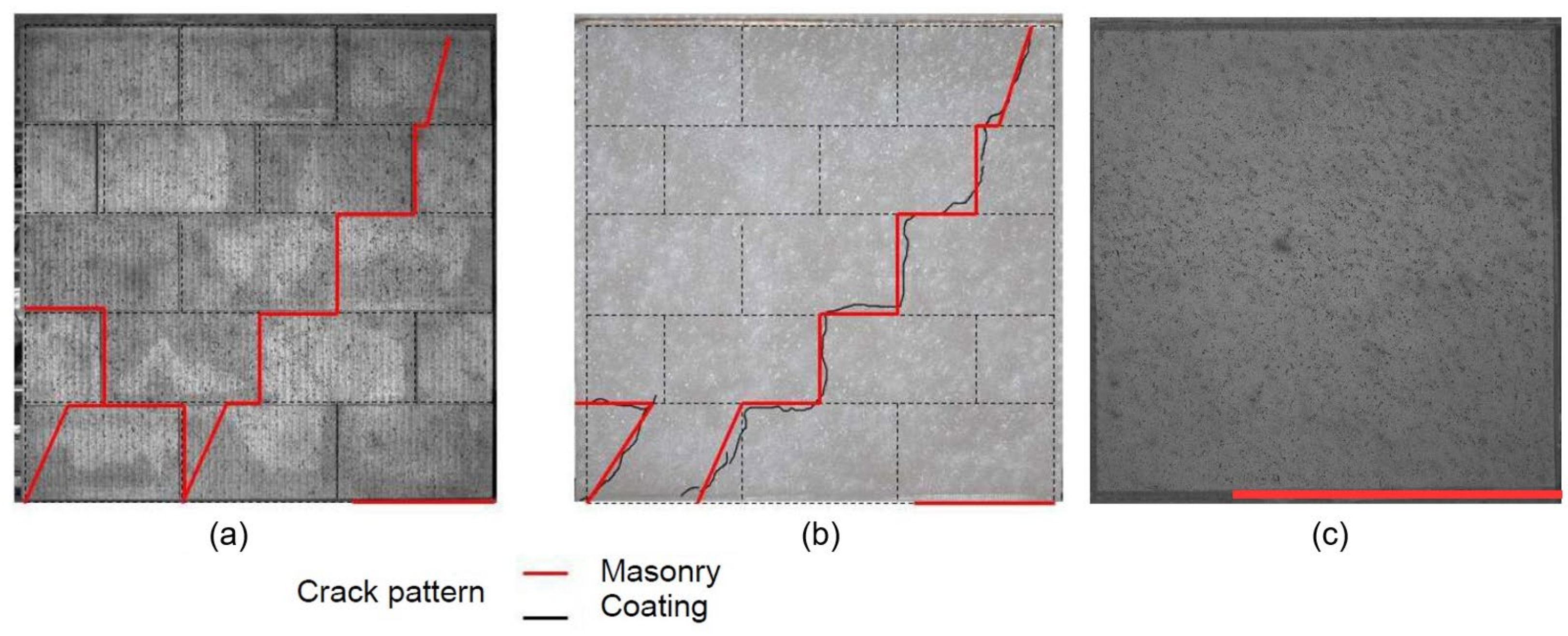

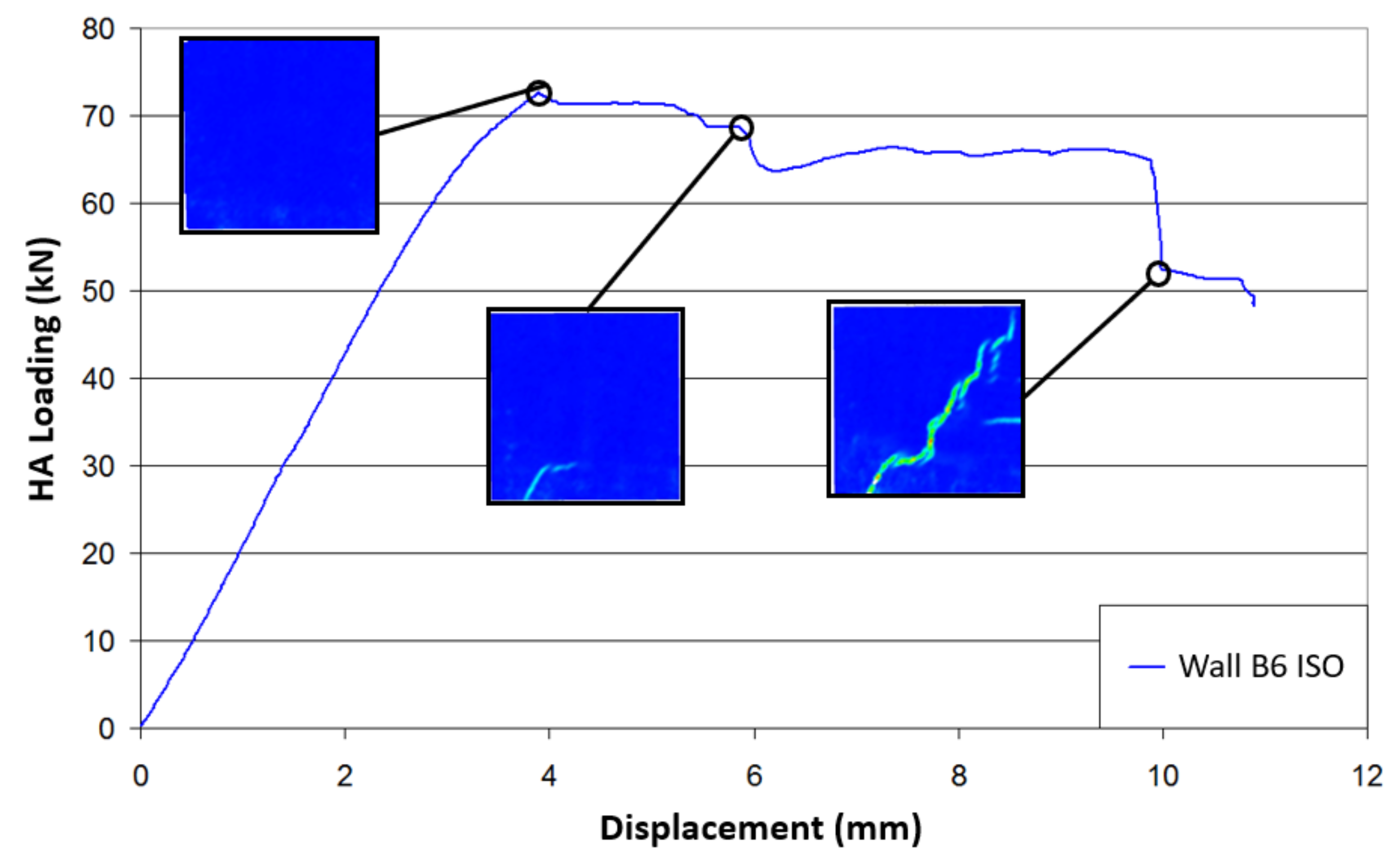

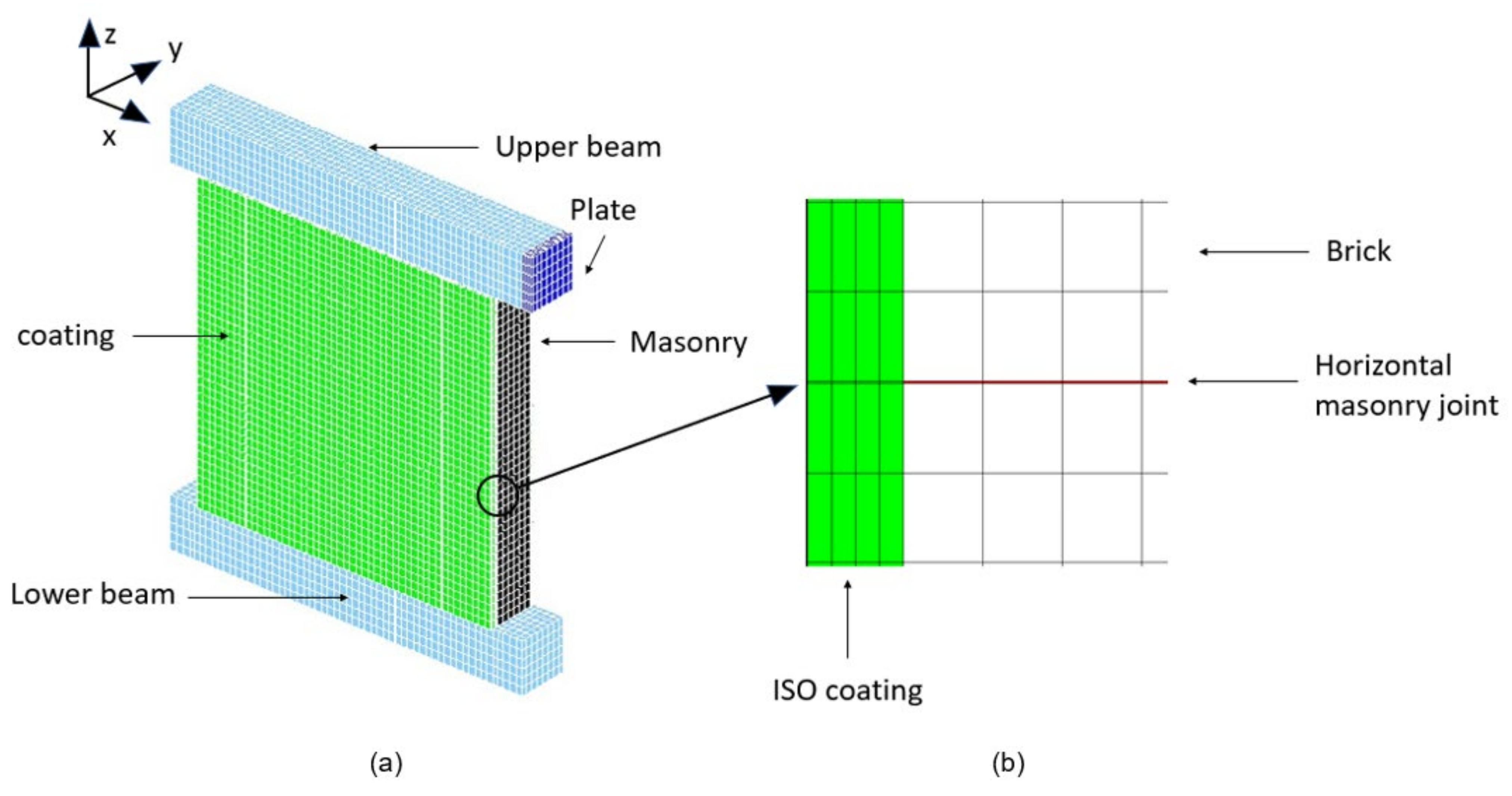
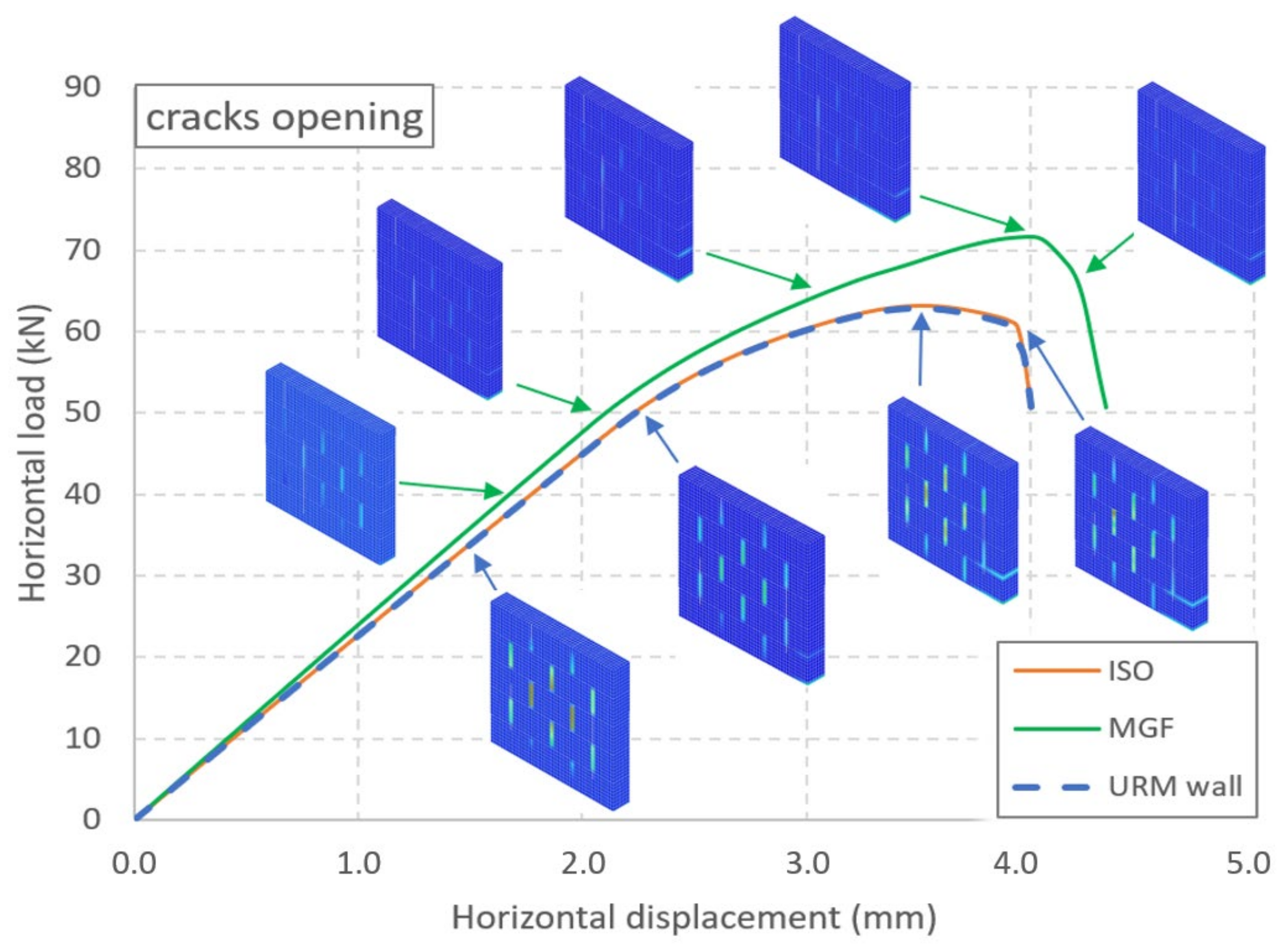
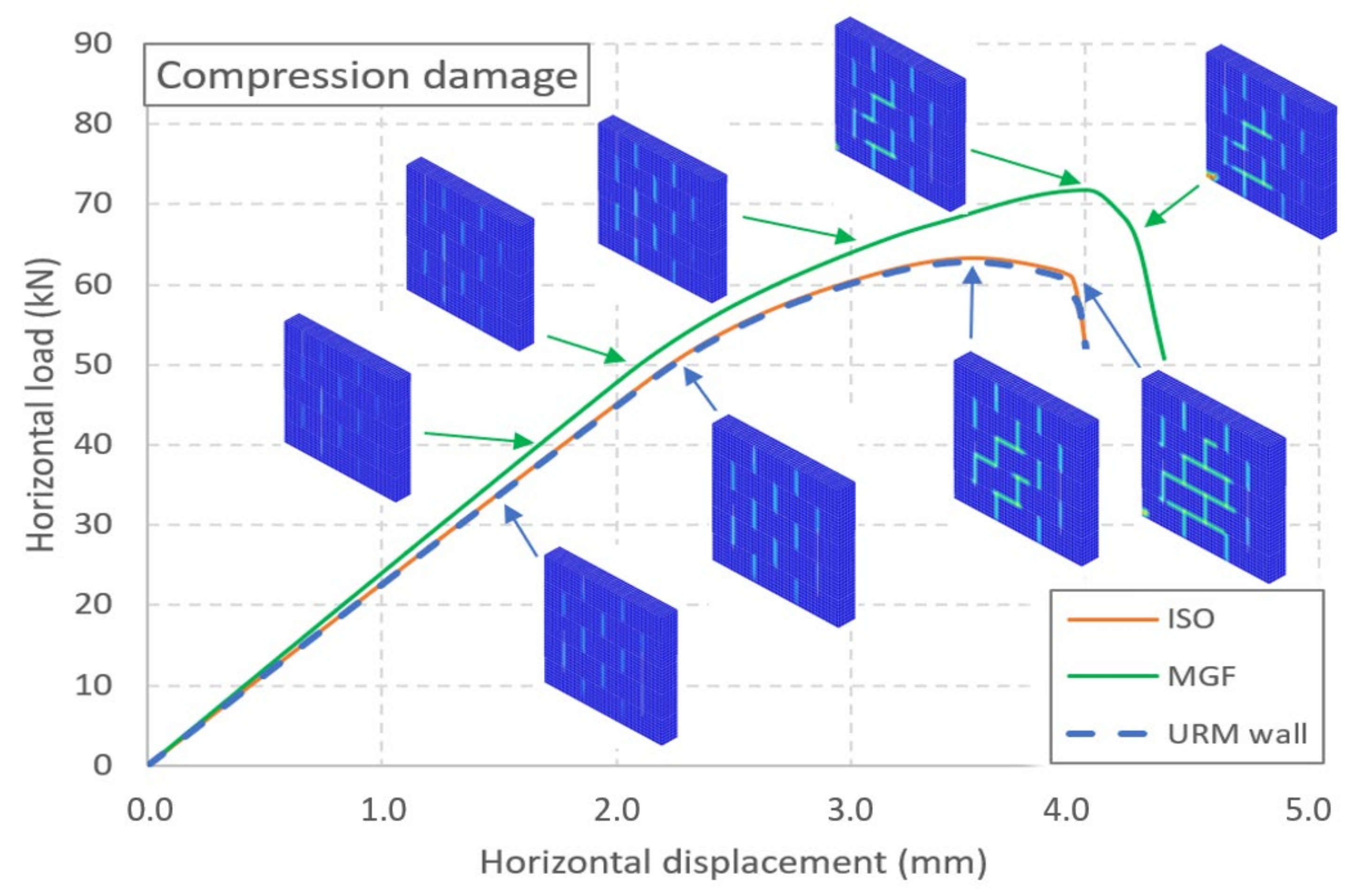
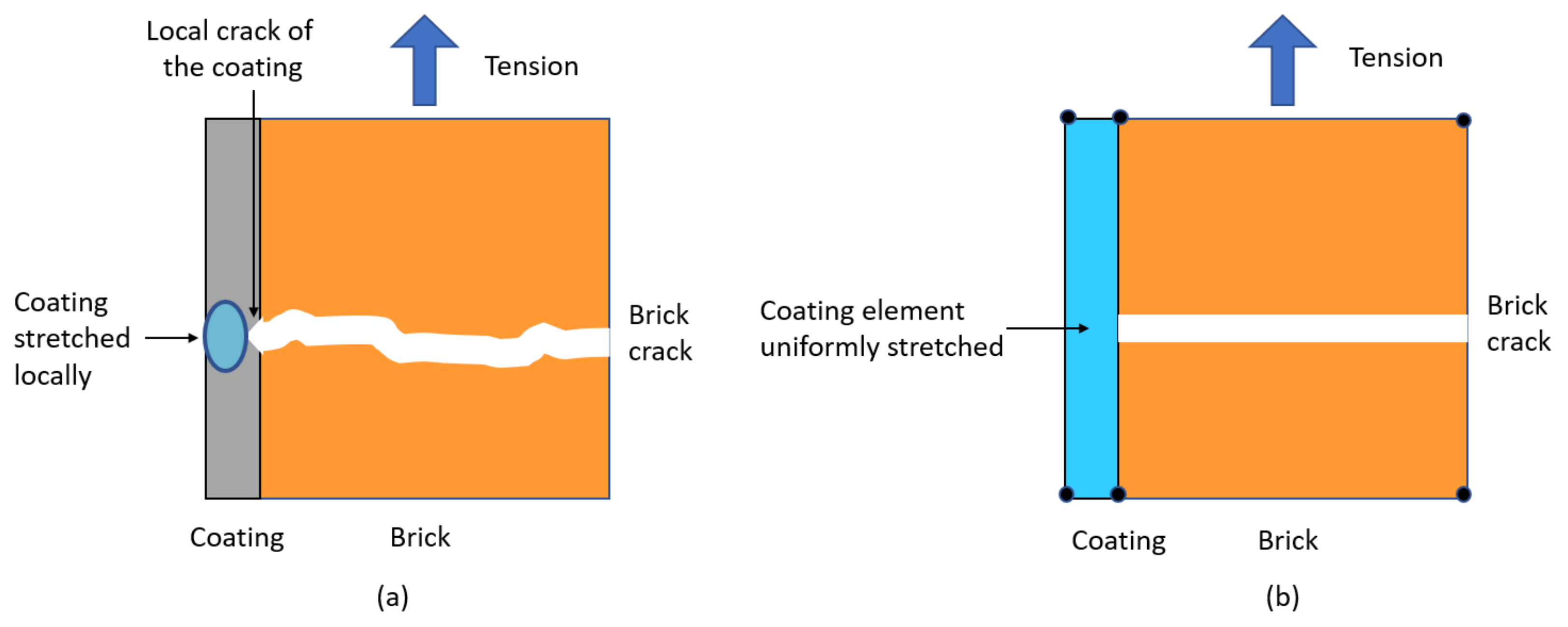
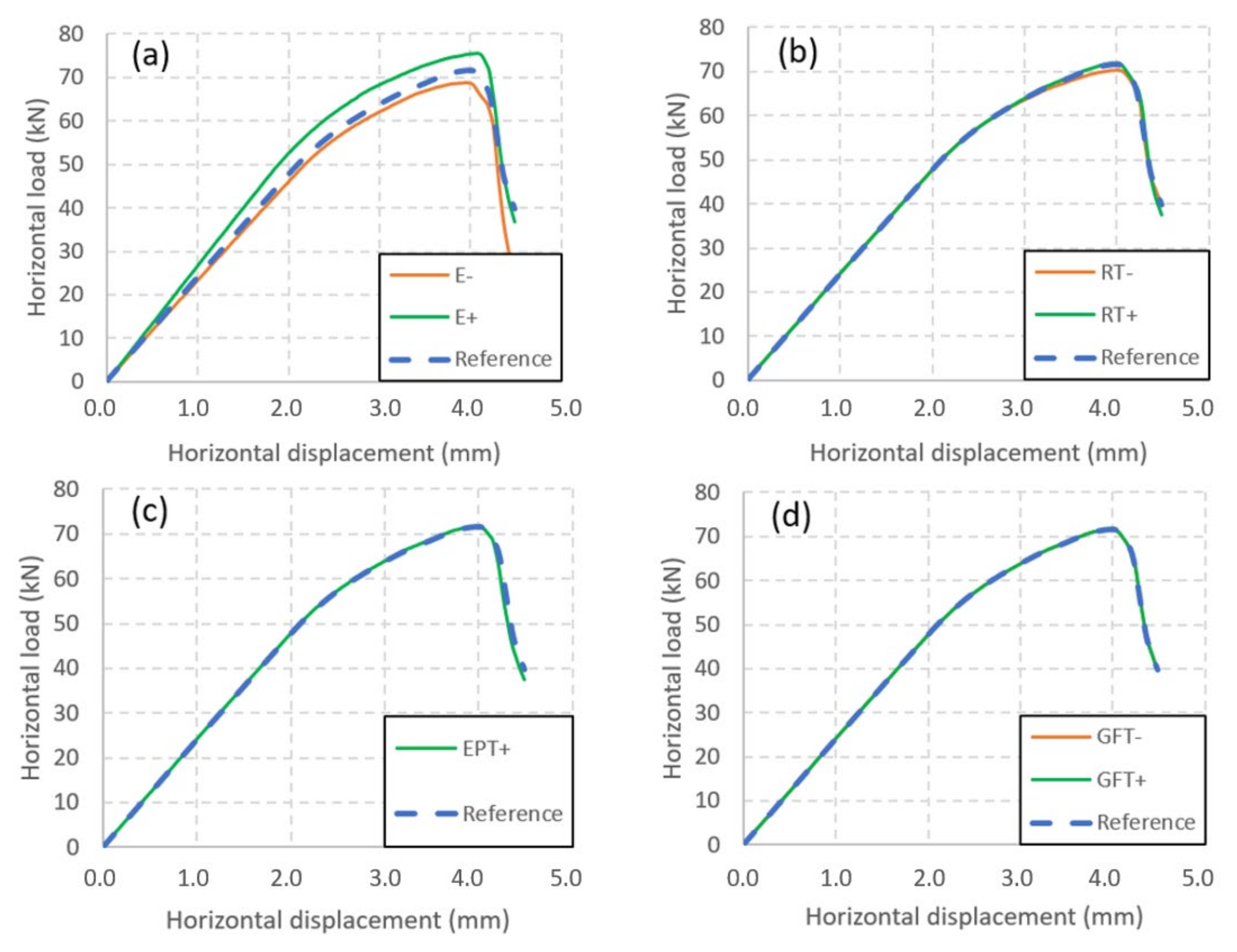
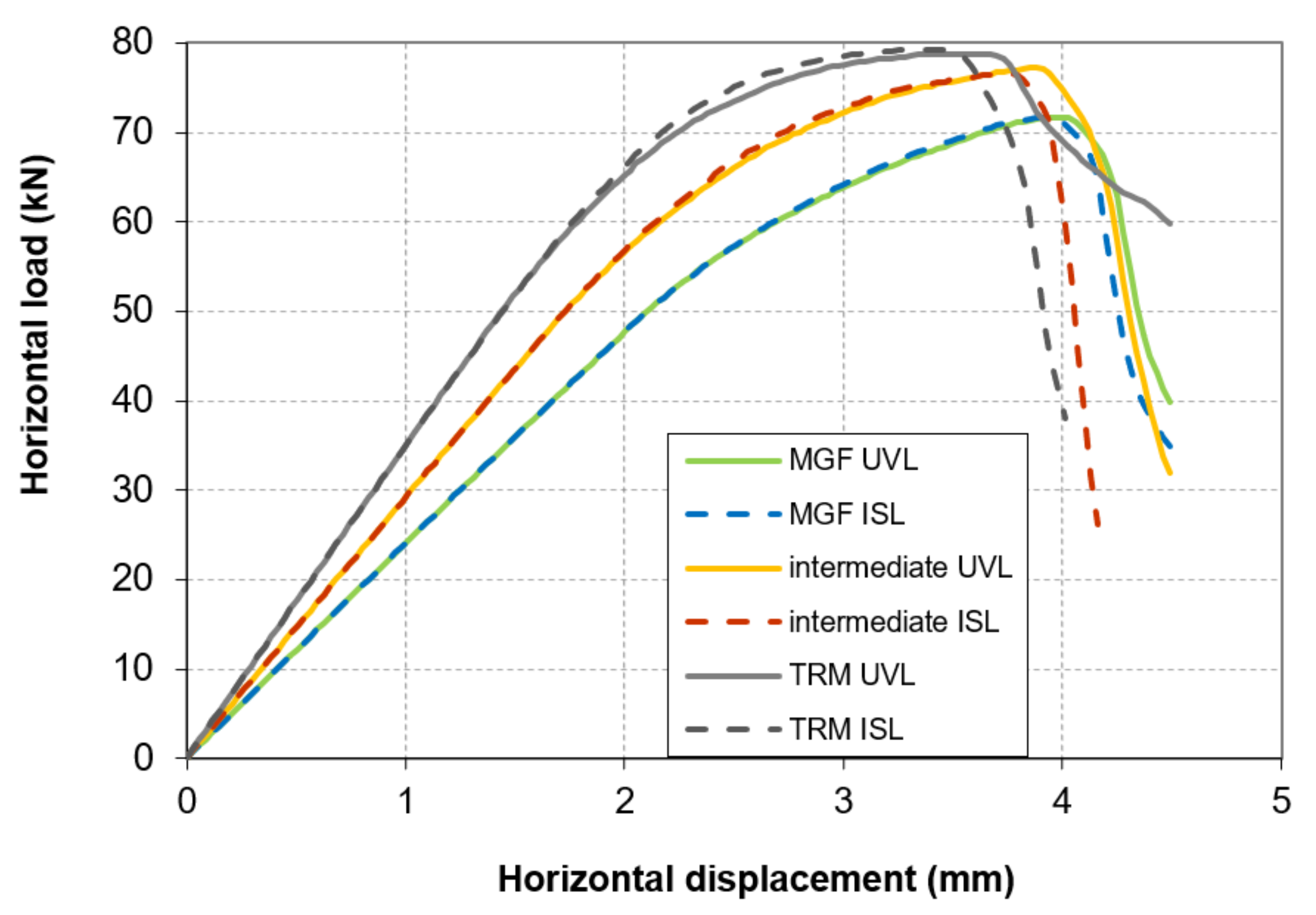
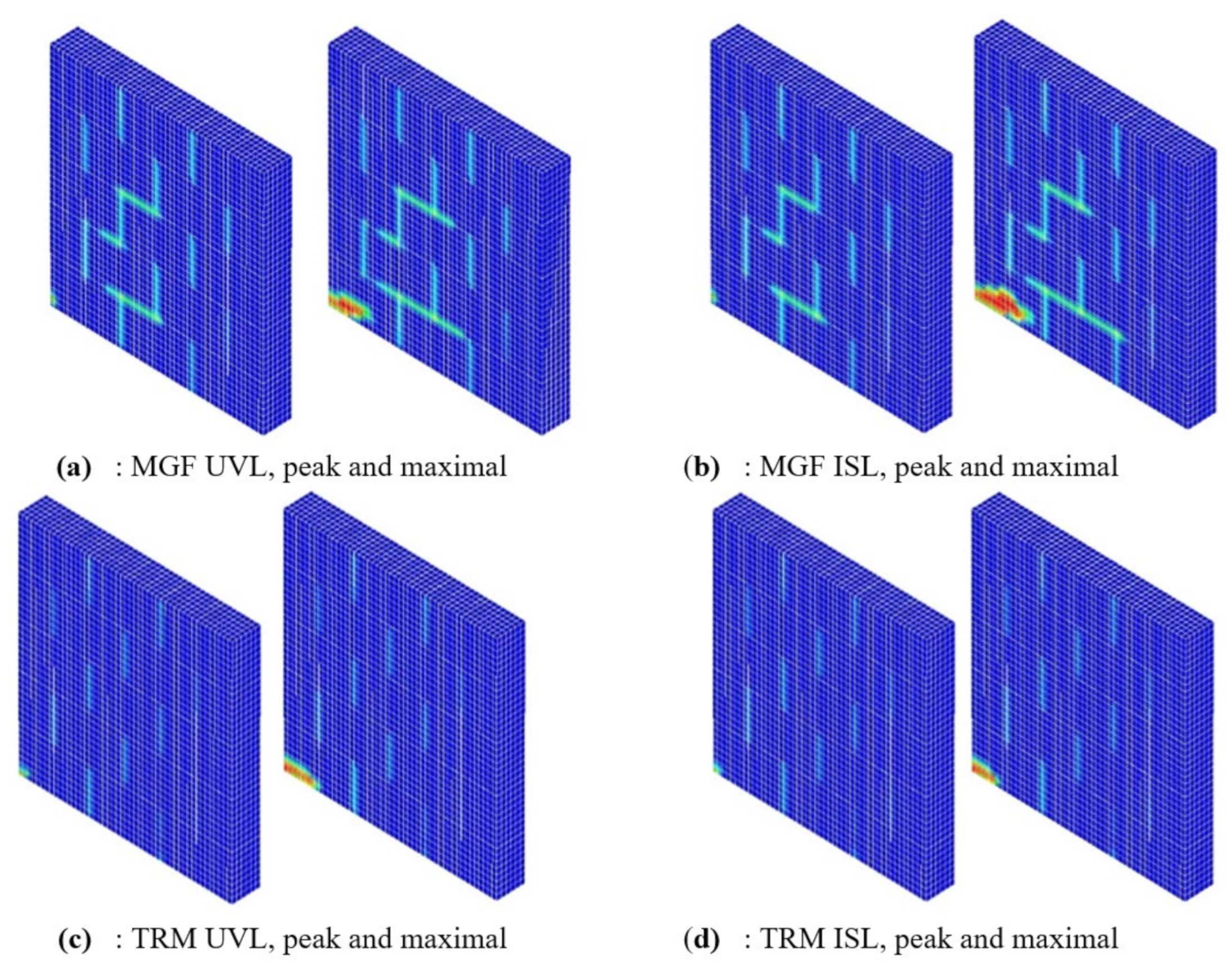
| Coatings | E (MPa) | ||
|---|---|---|---|
| ISO | 4 ± 1.4 | 70 ± 14 | 110 ± 30 |
| MGF | 300 ± 150 | 1289 ± 40 | 2900 * |
| Reference | Type of Coating | Coating Thickness (mm) |
|---|---|---|
| B1, B2 | Uncoated | - |
| B3, B4 | MGF | 10 |
| B6, B7 | ISO | 40 |
| Materials | Brick | Vertical Joints | Horizontal Joints | Bed Joints | ISO Coating | MGF Coating |
|---|---|---|---|---|---|---|
| Young’s modulus E (MPa) | 900 | 500 | 1000 | 4 | 600 | |
| Poisson ratio ν (-) | 0.2 | |||||
| Tensile strength (MPa) | 0.5 | 10−6 | 0.1 | 0.1 | 0.07 | 1.29 |
| Strain at tension peak (-) | ||||||
| Fracture energy under tension (MJ/m2) | ||||||
| Compression strength (MPa) | 3.0 | 2 × 10−6 | 1.0 | 3.0 | 0.11 | 2.9 |
| Strain at compression peak (-) | ||||||
| Characteristic strain (-) | 5 × 10−5 | 10−5 | 3 × 10−7 | 3 × 10−7 | 10−3 | 10−3 |
| Drucker Prager coefficient δ (-) | 0.6 | 1.0 | 1.0 | 1.0 | 1.2 | 1.2 |
| Dilatancy β (-) | 5.0 × 10−2 | 10−3 | ||||
| Reclosure characteristic stress (MPa) | ||||||
| Crack reclosure energy | ||||||
| Parameter | Reference Value | Conservative Value (CV) | Amplified Value (AV) |
|---|---|---|---|
| Young’s modulus E (MPa) | 600 | 200 | 1800 |
| Tensile strength (MPa) | 1.29 | 0.43 | 3.87 |
| Strain at tension peak (-) | - | ||
| Fracture energy under tension (MJ/m2) |
| Parameter | ||||
|---|---|---|---|---|
| Conservative value CV | 68.67 | 70.32 | - | 71.73 |
| Amplified value AV | 75.39 | 72 | 71.55 | 71.73 |
| Difference from reference case (%) | 9.4 | 2.3 | 0.2 | 0 |
| Name | Loading Type | Coefficient (-) | |||||
|---|---|---|---|---|---|---|---|
| MGF | UVL | 1.0 | 600 | 1.29 | 2.9 | 0.65 | 71.73 |
| ISL | 0.691 | 71.67 | |||||
| Intermediate | UVL | 5.0 | 300 | 6.45 | 14.5 | 0.517 | 77.19 |
| ISL | 0.691 | 76.68 | |||||
| TRM | UVL | 10.0 | 6000 | 12.9 | 29.0 | 0.415 | 78.80 |
| ISL | 0.689 | 79.23 |
Publisher’s Note: MDPI stays neutral with regard to jurisdictional claims in published maps and institutional affiliations. |
© 2021 by the authors. Licensee MDPI, Basel, Switzerland. This article is an open access article distributed under the terms and conditions of the Creative Commons Attribution (CC BY) license (https://creativecommons.org/licenses/by/4.0/).
Share and Cite
Plassiard, J.-P.; Eymard, M.; Alachek, I.; Plé, O. Pushover Tests on Unreinforced Masonry Wallettes Retrofitted with an Innovative Coating: Experimental Study and Finite Element Modelling. Materials 2021, 14, 6815. https://doi.org/10.3390/ma14226815
Plassiard J-P, Eymard M, Alachek I, Plé O. Pushover Tests on Unreinforced Masonry Wallettes Retrofitted with an Innovative Coating: Experimental Study and Finite Element Modelling. Materials. 2021; 14(22):6815. https://doi.org/10.3390/ma14226815
Chicago/Turabian StylePlassiard, Jean-Patrick, Mathieu Eymard, Ibrahim Alachek, and Olivier Plé. 2021. "Pushover Tests on Unreinforced Masonry Wallettes Retrofitted with an Innovative Coating: Experimental Study and Finite Element Modelling" Materials 14, no. 22: 6815. https://doi.org/10.3390/ma14226815






